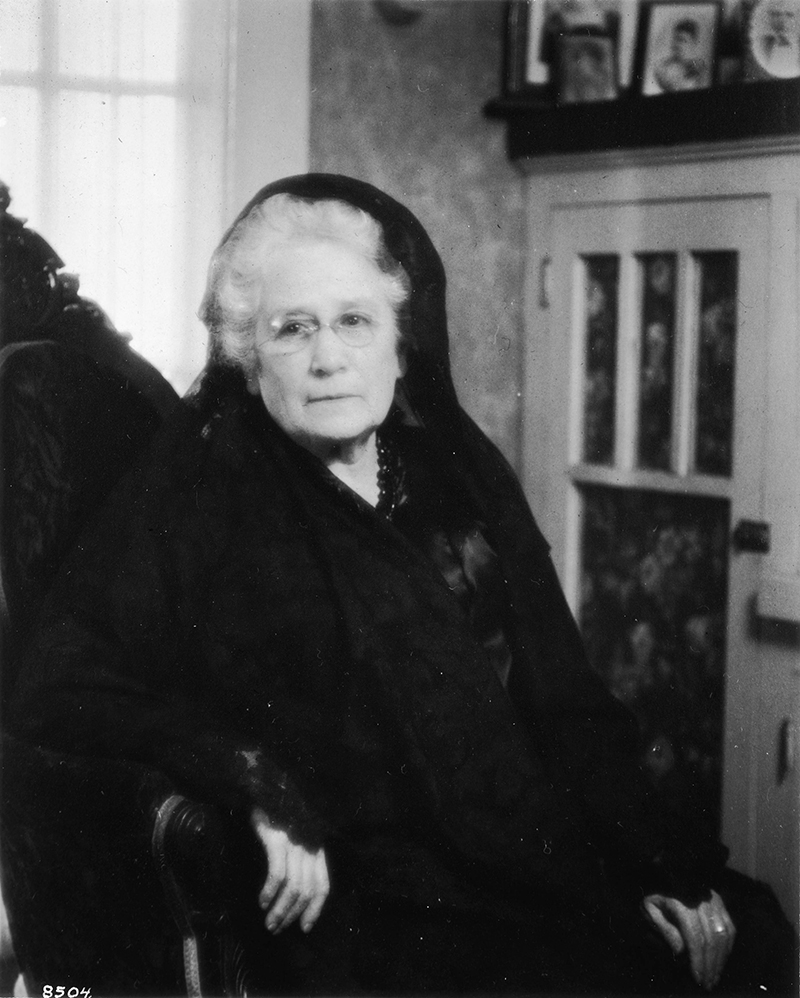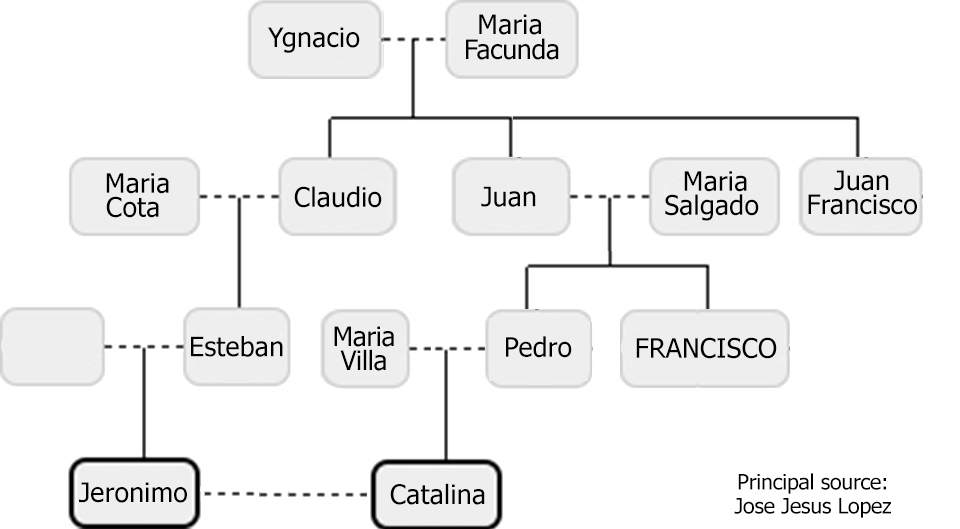|
|
Francisca Lopez de Belderrain
Source of Golden Dream Site & Story; Lopez Genealogy.

Click image to enlarge
Two Southland historians, Arthur Buckingham Perkins and Adolfo G. Rivera, conspired in 1930 to concoct the term, "Oak of the Golden Dream" — actually Perkins said "Tree of the Golden Dreams"[1] — but it was a story told to them by Francisca López de Belderrain [cq2] that gave them the idea. De Belderrain was a great-grandniece of Francisco López, who on March 9, 1842, made California's first documented discovery of gold in the Santa Clarita Valley. Who's Who First, some genealogy[3]. Jose Ygnacio Maria de Jesus López (Ygnacio) (aka Claudio?)[4] and his wife, María Facunda de Mora de López, were the founders of the López family in Alta California, arriving from Baja California by about 1771. They had (at least) three sons — Jose Maria Claudio López (Claudio), Juan Jose Francisco López (Juan Francisco), and Juan Bautista López (Juan) — some or all of whom were born in Mexico proper. Claudio served as mayordomo at the Mission San Gabriel for 40 years. Juan was mayordomo at Mission San Fernando, built in 1797. We'll call Ygnacio and Maria Facunda GEN-1. Juan (GEN-2) married María Dolores Salgado de López and had a number of children including Pedro López (1805-1859), Maria de Jesus López, and our man, Jose Francisco de Gracia López (Francisco). Pedro filled his father's shoes as mayordomo at San Fernando and in 1826 served as alcalde (mayor) of the pueblo of Los Angeles. Claudio (GEN-2) married María Luisa Cota de López and had a son, Esteban Ignacio Maria de Los Angeles López (Esteban). Pedro (GEN-3) married Maria Ygnacia Villa and had a daughter, Catalina. Esteban (GEN-3) had a son, Jeronimo.
Catalina and Jeronimo built the López Adobe in 1882-83; itstill stands at 1100 Pico Street. Francisca López de Belderrain was GEN-6. Her father's name was Francisco López[5] (GEN-5). Francisca was "well acquainted"[6] with Catalina, who may have been her grandmother, but we are not certain. Which brings us to the story. Recollections Los Angeles-born historian Charles Prudhomme (1854-1934) set about in the early 1920s to debunk the myth that the gold discovery at Sutter's Mill on the American River was California's first. He wasn't the first to do it, and he wouldn't be the last, but it needed doing again. Prudhomme tracked down Francisca López de Belderrain and interviewed her. Francisca told him that in the fall of 1914, the family matriarch, Señora Catalina, invited all of her relatives to a "reunion picnic on the spot where the first gold was discovered in 1842." Francisca attended the picnic.[7] At this 1914 picnic, according to Francsica, Catalina told her descendants that in 1843, when she was 12 years old, Catalina attended a first-year anniversary celebration of her uncle's famous discovery. Francisca said Catalina testified that she remembered the first celebration on the same spot "very distinctly," Prudhomme writes. On Nov. 21, 1920, Prudhomme, along with Francisca and a couple of other people set out in a "high-powered machine" and headed north from Los Angeles, intent on locating the spot. When they reached Placerita Canyon they encountered "a nice lady, Mrs. F.E. Walker, and her children," who joined the little party. Prudhomme writes: "We had not proceeded far before Mrs. de Bilderrain [sic], pointing to a certain spot, said: 'This is the place of the discovery; this is the exact location.'" They found "a place where the slope had been levelled down, and a place made for the temporary altar, on which they had celebrated the mass" at the 1843 get-together. Investigating further, they found placer workings, probably from the late 1800s. Francisca told Prudhomme the story as she remembered hearing it in 1914: "Don Francisco López, who was greatly trusted by the padres, had at this time charge of their cattle and stock in this section. And one day in the year 1842, when in company with another herdsman he sought some stray animals, they happened to ride into this Canyon, known as Placerito. These men, being weary, tethered their tired horses, and proceeded to make themselves comfortable, taking their siesta under the shade of the oak tree. After resting awhile, Don Francisco spied some bunches of wild onions growing nearby, and calling to mind that his aunt, at parting with him recently, had requested him to bring her home the first of these he could find, he began to pluck up some of these wild onions by the roots, and while thus engaged, to his astonishment he noticed attached to the roots of the onions, certain curious shining pebbles…" The story was repeated in February 1930, in anticipation of the March 9 anniversary that year. This time it was A.B Perkins and Adolpho G. Rivera who were the architects of the Sutter's Mill myth-busting. This time they would try to make it stick. They would make a spectacle of it. They contacted Francisca López de Belderrain and on Feb. 23, 1930, had her swear to the story with her signature on an "affidavit" administered by the justice of the peace — which conveniently happened to be Perkins. She again told of "the tree under which [Francisco] slept his mid-day siesta"[8], and on March 9, before a large crowd that had gathered in Placerita Canyon, Perkins went into histrionics about Francisco López arising "from under that Tree of the Golden Dreams, and ma[king] that epochal Discovery of Gold." Then, the organizers unveiled a bronze tablet they had affixed to a group of boulders marking the discovery site — boulders that Frank Walker supposedly discovered and unearthed only recently — and they bolted a commemorative plaque into an oak tree that Adolfo Rivera selected for the occasion. Thus do we have the Oak of the Golden Dream. But Francisca López de Belderrain was not the first person to give us Placerita Canyon as the discovery site. Other Sources The reader should be aware that most sources from the 1800s merely identify the Rancho San Francisco, sometimes called Rancho San Francisquito, as the discovery site. There has been some debate as to which part of the Rancho San Francisco was meant. Before 1839, when 48,000 acres of the Rancho San Francisco were mapped and deeded to Antonio del Valle, the rancho was ill-defined and generally considered to encompass more than 100,000 acres. Placerita Canyon appears to have been included in the 1839 rancho. So was the mouth of San Francisquito Canyon, where gold was plentiful in the mid-1800s. Francisco López is known to have mined gold in San Feliciana Canyon (Piru area) in 1843, and some speculate the 1842 discovery could have been made there. The canyon would have been part of the pre-1839 Rancho San Francisco, and even in 1842, it would have been thought so; the Rancho Temescal, encompassing San Feliciana and Hasley Canyons, did not come into being as a separate property until 1843 when it was granted to Francisco López. But there are a couple of early sources other than Francisca López de Belderrain that point to Placerita. One is a separate version of the Catalina López story. It is recapitulated in 1927 by Fr. Zephyrin Engelhardt, O.F.M., the mission historian at Santa Barbara. It's essentially the same story, but without the nap or the tree or the precise location. Instead, it identifies the discovery "in San Feliciano Cañon, on the same San Francisquito Ranch," as having occurred one year after Francisco López's initial discovery on a different part of the rancho. Importantly, this version of Catalina's story comes not through Francisca López de Belderrain, but through Rev. Eugene Sugranes, C.M.F., who reportedly heard it directly from Catalina.[9] One final sourcing of Placerita Canyon as the discovery site has nothing to do with Catalina. We haven't seen the original, but Prudhomme (1922) tells us Cyrus Lyon, who arrived in Los Angeles in 1849 at age 18 and worked for John Temple, kept "notes." According to Prudhomme, the notes include the following entry: "I was so informed that in 1842, forty-five miles northwest from the Pueblo, were discovered the Placerito Placer by Francisco López. And the same year he discovered the San Feliciana placer mine."[10] Cyrus Lyon died in 1892, twenty-two years before Francisca López de Belderrain learned the details and the location of her ancestor's discovery. — Leon Worden 2015 1. See Perkins here. 2. Her name appears several different ways; we're using the spelling she used herself as seen here. 3. Most of the genealogy comes from Jose Jesus López, a son of Catalina and Jeronimo López. See this excerpt and see Jose Jesus' full account of his family history in Latta (1976). Full names provided by Lynn Adams (PC 2015), a descendant of Juan Bautista López (Francisco's father) via Juan's daughter, Maria de Jesus López. 4. It should be noted that Francisco López's obituary in the Los Angeles Times identifies his grandfather as "Claudio." But Jose Jesus López is quite specific and repetitious about his ancestry, and it's not possible unless Claudio was an alias for Ygnacio. Claudio was Francisco's uncle. 5. Information from card file entry for Photo CHS-8504 in California Historical Society collection. 5. See De Belderrain affidavit, op. cit. 6. See Prudhomme (1922). 7. De Belderrain, op. cit. 8. See Engelhardt (1927). 9. Prudhomme, op. cit.
US8504: 9600 dpi jpeg from digital image in USC Digital Library; California Historical Society catalog No. CHS-8504. |
Dissecting the Dream: Fact, Fiction & the Golden Oak, by Alan Pollack
New York Observer 10-1-1842
U.S. Treasury Voucher 1843
Abel Stearns Letter 1867
Francisco Lopez
Pedro Lopez (Brother)
Maria Felis (Wife)
Maria Concepcion (Daughter)
Francisco Ramon (Son)
Catalina (Pedro's Daughter)
Francisco "Chico" Lopez Obituary 1900
As Told by Jose Jesus Lopez
Sutter's Fort Error 1905
Prudhomme 1922
Engelhardt 1927
Francisca Lopez de Belderrain
Belderrain Story 1930
Who's Who, by Belderrain
• Story: Sutter, Marshall Knew They Weren't First
|
The site owner makes no assertions as to ownership of any original copyrights to digitized images. However, these images are intended for Personal or Research use only. Any other kind of use, including but not limited to commercial or scholarly publication in any medium or format, public exhibition, or use online or in a web site, may be subject to additional restrictions including but not limited to the copyrights held by parties other than the site owner. USERS ARE SOLELY RESPONSIBLE for determining the existence of such rights and for obtaining any permissions and/or paying associated fees necessary for the proposed use.











